[Backstory: I opted to be a part of the White Elephant Blog and some monster assigned a Ken Russell film to me. I got what I deserved since I gave some poor sap ROLLER GATOR. All of the participants and their assignments can be found over at Paul Clark’s site.]
PASSION is essentially one protracted giggle at dicks, bush, and everything in between. Tellingly, the film opens with a character telling a joke that was probably pulled from one of those “UNCLE DIRTY’S BEST XXX-RATED HUMOR” tomes you see for sale at seedy rest stops.
The filmmakers promise a scandalous exploration of forbidden sexuality and delivered a silly meander through Zalman King territory. While they’re at it, they throw in a ham-fisted expose of (perceived) suburban ennui.
Take a good look at Laughlin’s expression. It’s the only arrow in his thespian quiver. He will use it to express ecstasy, anger, joy, thinking, etc.
Next we meet Kathleen Turner as China Blue:


When the above title card appeared – less than a minute in to Ken Russell’s 1984 CRIMES OF PASSION – I confess I chortled like a tubby eighth grader. Over the next hundred minutes or so, my puerile tittering would receive its due punishment.
PASSION is essentially one protracted giggle at dicks, bush, and everything in between. Tellingly, the film opens with a character telling a joke that was probably pulled from one of those “UNCLE DIRTY’S BEST XXX-RATED HUMOR” tomes you see for sale at seedy rest stops.
The filmmakers promise a scandalous exploration of forbidden sexuality and delivered a silly meander through Zalman King territory. While they’re at it, they throw in a ham-fisted expose of (perceived) suburban ennui.
After the credits, we open on a group therapy session. The group’s purpose is unclear. They apparently gather to swap dirty jokes and jab at each other for being too lecherous, not getting laid enough, getting laid too much… not sure. The camera pans over from respectable actor Bruce Davison – who will have less than ten lines in the whole film, despite being among the top-billed – to John Laughlin, an actor who gets one of those coveted “and introducing… “ credits:
Laughlin plays Bobby, a regular sorta all-American guy. Bobby is teased by the group for being a Boy Scout without any sexual baggage. He claims he’s just there to support his friend (Davison) while insisting he has a perfectly good marriage and sex life. OR DOES HE?!
Next we meet Kathleen Turner as China Blue:
She’s one of those such-and-such-by-day/hooker-by-night characters that are a staple of this sort of film. Here she’s giving a patriotic speech while the Casio soundtrack lazily plays some sort of synth Battle Hymn.
The camera slowly pulls back to reveal:
She’s with a john! Who has asked her to adopt the persona of Miss Liberty, southern patriot with a Blanche Dubois affectation! She’s proclaiming her love for God, country, and middle American values while participating in illicit sex! SUB-VERSE-IVE!!!!
Everything in PASSION – subtext, context, text – is broadcast through a deranged megaphone.
Now we meet our second antagonist:
Poor Anthony Perkins plays a deranged priest. Originally, the character was a shoe salesman; Perkins and Russell thought making him a man of the cloth would be a better swipe at the Middle American values they were seeking to undermine.
Perkins is introduced at a peep show, snorting amyl nitrate, and fantasizing about killing the lady in the booth. And he’s a priest. Again: SUBVERSIVE!
Meanwhile, here’s a post-fellatio China Blue with her john:
Note the color shift in the background. Every scene set in Ms. Blue’s boudoir is constantly barraged by blinking neon light. I have a feeling Russell and Bush were going for some sort of lurid dualism: each person has a randy, neon-red sex maniac buried under their staid persona. Well, consider this square's mind BLOWN. Intent aside, the effect is headache-inducing.
Note also the lacy wallpaper pattern. We’ll get to that in a minute.
Throughout the film, Russell intercuts China Blue’s sexual dalliances with antique/ancient depictions of sex. The triptych above flashes onscreen while she’s turning her first trick. This is Ken Russell’s idea of SYMBOLISM, though I’m not sure exactly what it means (and, to listen to the commentary, neither is he).
Now we move on to Bobby’s home in dreaded suburbia:
On the commentary, screenwriter Barry Sandler sneers, “We set him up.” Russell agrees, chiming in: “John Laughlin plays a repressed American suburbanite … living in suburbia with his middle class wife and his middle class children in his middle class house, wondering why he’s unfulfilled.”
Here is his middle class wife, played by a pre-Designing Women Annie Potts:
This is her “I’m plotting some shrewin’” expression, one that she’ll have to wear throughout most of her scenes. Unlike Laughlin, however, Potts comports herself with dignity in a role that has none.
Bobby and his wife are drifting apart, as Bush and Russell lay out explicitly for us with more SYMBOLISM:
Douglas Sirk, this aint. Bobby is content to run some sort of home security outfit and make enough to keep generic beer and plates of shredded meat on the table. Potts wants a hot tub, an obvious symbol of the repressed American bourgeois consumerist Middle Class life she longs for.
Here are their kids:


Note again the color shift. Other than the red light district, the only time the filmmakers play this little trick is when Bobby and his family are watching TV. Because suburbanites watching the telly are little better than whores. Or something.
Once Bobby and his wife have discussed the hot tub, some plotting kicks in. To pay for the tub, Bobby will have to take on extra work. He’s tasked with tailing a woman who works for a fashion design company. At night, the woman turns into China Blue.
China Blue is too mysterious and tantalizing for Bobby to resist. They end up having Quaaludes-n-sex in a ridiculously protracted scene shot all in silhouette. I forgot to get a frame grab from this sequence before shipping the film back to Netflix. You’ll have to use your imagination, something the creators of CRIMES OF PASSION failed to do most of the time.
Here is one scene where they did strain their creative powers to the fullest. It’s one of three sequences that cut to the quick of what the film IS. The first is the aforementioned Miss Liberty bit. I’ll get to the third later. But, if you wanted to check out the Cliff Notes of the film, this is really all you need.
Bobby and Wife are sitting, soul-deadened, watching their TV:
Some sort of program about an upper-class married couple comes on:
We’re immediately transported into some bizarre music video wherein the couple flaunt their riches…
... to Rick Wakeman playing a photographer...
(Incidentally, Wakeman contributes a score that probably took him fifteen minutes to compose; it’s an eight-note riff on Dvorak’s New World Symphony which, Russell points out, is a subtle reference to both America and Roger Corman’s New World Pictures, who distributed the film.)
The married bourgeoisie’s prized possessions are suddenly sucked up into the air...
… and dropped into a swimming pool (an echo of Bobby’s wife’s longed-for hot tub, perhaps):
... and become ossified caricatures of themselves:
This sequence is where I became suspicious that the film was perhaps a parody of an expose of the soul-crushing nature of the American suburbs.That’s the difficulty of CRIMES OF PASSION: it’s so good at being so bad. Russell’s no slouch. He (and Bush) know what they’re doing.
However, if the commentary is any indication, Russell earnestly means every frame as an indictment of American Values. (To be fair, Russell actually spends most of the commentary apolitically, preferring to spout lazy double entendres meant to bring the conversation back around to his favorite subjects: dicks, bush, and the like.)
The film is writ so large and purple, it’s hard to admire it even when it is effective. For instance, after China Blue and Bobby have their sex-a-thon, Anthony Perkins stabs a stripper to death. Cribbing from Nicholas Roeg at his most schizophrenic, Russell intercuts the murder of the flesh-and-blood stripper with the “murder” of a blow-up doll:
The scene manages to be effectively unsettling but undermines itself with a murder weapon that's impossible to take seriously:
Yes. That IS a sharpened sex toy.
The plot moves along. Newly liberated Bobby and his wife have friends over for a barbecue. They are snippy with each other. He keeps threatening her with an act called “the HP.” She begs him not to “do the HP.”
Rather than give in to her henpecking, Bobby appears on their deck in full HP regalia:
Rather than give in to her henpecking, Bobby appears on their deck in full HP regalia:
Yes, “HP” = “human penis.” It’s one of the most humiliating things I’ve seen an actor do (Carice Van Houten’s vat-o’-feces in BLACK BOOK is the only contender). I can’t think of a better “actor” to fill the role of the HP than John Laughlin.
Bobby’s wife is (quite justifiably) horrified, disgusted, and disappointed in her spouse:
However, I honestly believe that Russell expects us to side with Bobby here. To see the wife as a repressive killjoy and delight in Bobby’s libertine sexuality.
After the HP debacle (too bad, by the way, the film bombed at the box office; the potential tie-in with Hewlett Packard never materialized), Bobby and wife have a stony evening in bed where she confesses her distaste and shyness where sex is concerned.
Here’s more of Russell’s SYMBOLISM:
Remember how I mentioned the lacy pattern on the wall of China Blue’s whore hideaway? It’s difficult to tell from the screen grab, but the same pattern is used by Bush and Russell here, superimposed over the icy couple. You see, the lacy sex net of China Blue has been cast over Bobby. There’s no turning back!
Bobby breaks it off with his wife and goes to China Blue’s actual home. Here they fight over something I can’t remember:
I took the screen grab to show Turner’s bizarre, Timothy Carey-ish expression, one she wears throughout the film (and her career). It’s her default setting when she’s not hamming it up as China Blue.
After they argue and make up, Bobby and China Blue have sex in her apartment. Bush and Russell back-light their languid lovemaking under amber sheets, giving it an almost embryonic appearance:
Back to the womb for Bobby!
Instead of intercutting this sex session with antique depictions of naughtiness, Russell zooms in on Klimt’s “Kiss.”
Apparently, sleeping with a hooker when she’s off-duty represents a return to innocence.
CRIMES builds to the inevitable climax wherein Preacher Perkins attempts to kill China Blue because she’s a sinful harlot. Again, poor Perkins:
This is the third scene that tells you all you need to know about the film: Russell believes putting a blade-wielding Perkins in a wig and dress is a sly, winking homage. I needn’t tell you that it comes off instead as a cheap insult so broad in its “knowingness” it would be at home in a Friedberg/Seltzer film. I'm ashamed to post this on the fiftieth anniversary of PSYCHO.
Perkins is thwarted and Bobby and China Blue are reconciled. We find ourselves back in group therapy:
Though the facial expression has changed very little, Bobby informs us that he’s found a happy, vibrant relationship with his new lover. Things are unsure and unstable but they’re both keeping it real and not hiding from who they really are blah blah blah. To send us on our way, he looks directly into the camera and says something to the effect of: “And we sure f*ck each other’s brains out.” Smirk. End credits. Two more frame grabs:
John Laughlin, actor:
Annie Potts, summing up my reaction:































No comments:
Post a Comment